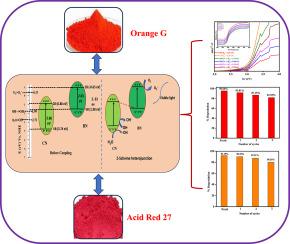Neodymium doped Bismuth oxybromide anchored graphitic carbon nitride Z-Scheme heterojunction photocatalyst for photodegradation of Acid Red 27 and Orange G dyes and its mechanism insights
IF 4.6
3区 材料科学
Q2 MATERIALS SCIENCE, MULTIDISCIPLINARY
引用次数: 0
Abstract
For the first time, a neodymium (Nd)-doped Bismuth oxybromide anchored with graphitic carbon nitride nanocomposite (NCs) was synthesized, and its photocatalytic performance was evaluated for dye degradation to address environmental pollution issues. Nd was selected as a dopant owing to its unique 4f electronic configuration, which introduces defect levels within the band gap, enhances visible-light absorption, and promotes efficient charge separation, thereby significantly improving photocatalytic activity for dye degradation. The synthesized materials include BiOBr:Nd (BN), g-C3N4 (CN), and a series of nanocomposites: BiOBr:Nd-CN-1 (BNCN-1), BiOBr:Nd-CN-2 (BNCN-2), BiOBr:Nd-CN-3 (BNCN-3), and BiOBr:Nd-CN-4 (BNCN-4), prepared via the coprecipitation method. XRD analysis confirmed the tetragonal phase of BiOBr in BN, with no distinct Nd peaks, indicating successful doping, while the (100) and (002) planes verified the formation of graphitic CN. In BNCN-1 and BNCN-2, CN related peaks were absent due to its lower concentration, whereas BNCN-3 and BNCN-4 displayed weak (002) peaks, confirming successful nanocomposite formation. Morphological analysis revealed Bi-based clusters embedded over thin CN layers, and TEM images confirmed a strong BN–g-C3N4 interface. BET analysis showed that BNCN-3 had the most favorable porous structure, correlating with superior photocatalytic efficiency. The band gaps, determined using diffuse reflectance spectra and Kubelka–Munk analysis, were 2.63, 2.86, 2.75, 2.60, 2.55, and 2.78 eV for BN, CN, BNCN-1, BNCN-2, BNCN-3, and BNCN-4, respectively. Under visible-light irradiation for 90 min, BNCN-3, achieved degradation efficiencies of 92.10 % for Orange G and 95.64 % for Acid Red 27. Scavenger tests revealed the dominant reactive species involved in the process, and the nanocomposite exhibited good reusability, demonstrating its potential as an efficient and sustainable photocatalyst for wastewater treatment.

钕掺杂氧化溴化铋锚定石墨氮化碳Z-Scheme异质结光催化剂光降解酸性红27和橙G染料及其机理研究
首次合成了一种以石墨氮化碳为锚定的钕掺杂氧化溴化铋纳米复合材料,并对其光催化降解染料的性能进行了评价,以解决环境污染问题。选择Nd作为掺杂剂是因为其独特的4f电子结构,可以在带隙内引入缺陷水平,增强可见光吸收,促进有效的电荷分离,从而显着提高染料降解的光催化活性。合成的材料包括BiOBr:Nd (BN)、g-C3N4 (CN),以及通过共沉淀法制备的BiOBr:Nd-CN-1 (BNCN-1)、BiOBr:Nd-CN-2 (BNCN-2)、BiOBr:Nd-CN-3 (BNCN-3)和BiOBr:Nd-CN-4 (BNCN-4)等一系列纳米复合材料。XRD分析证实BiOBr在BN中存在四方相,没有明显的Nd峰,表明掺杂成功,而(100)面和(002)面证实了石墨CN的形成。在BNCN-1和BNCN-2中,由于其浓度较低,没有CN相关峰,而BNCN-3和BNCN-4则出现弱(002)峰,证实了纳米复合材料的成功形成。形态学分析显示bi基簇嵌在薄薄的CN层上,TEM图像证实了强BN-g-C3N4界面。BET分析表明,BNCN-3具有最有利的多孔结构,具有较好的光催化效率。通过漫反射光谱和Kubelka-Munk分析,BN、CN、BNCN-1、BNCN-2、BNCN-3和BNCN-4的带隙分别为2.63、2.86、2.75、2.60、2.55和2.78 eV。在可见光照射90 min下,BNCN-3对橙色G的降解效率为92.10%,对酸性红27的降解效率为95.64%。清道夫实验表明,该纳米复合材料具有良好的可重复使用性,表明其作为一种高效、可持续的光催化剂的潜力。
本文章由计算机程序翻译,如有差异,请以英文原文为准。
求助全文
约1分钟内获得全文
求助全文
来源期刊

Materials Science and Engineering: B
工程技术-材料科学:综合
CiteScore
5.60
自引率
2.80%
发文量
481
审稿时长
3.5 months
期刊介绍:
The journal provides an international medium for the publication of theoretical and experimental studies and reviews related to the electronic, electrochemical, ionic, magnetic, optical, and biosensing properties of solid state materials in bulk, thin film and particulate forms. Papers dealing with synthesis, processing, characterization, structure, physical properties and computational aspects of nano-crystalline, crystalline, amorphous and glassy forms of ceramics, semiconductors, layered insertion compounds, low-dimensional compounds and systems, fast-ion conductors, polymers and dielectrics are viewed as suitable for publication. Articles focused on nano-structured aspects of these advanced solid-state materials will also be considered suitable.
 求助内容:
求助内容: 应助结果提醒方式:
应助结果提醒方式:


